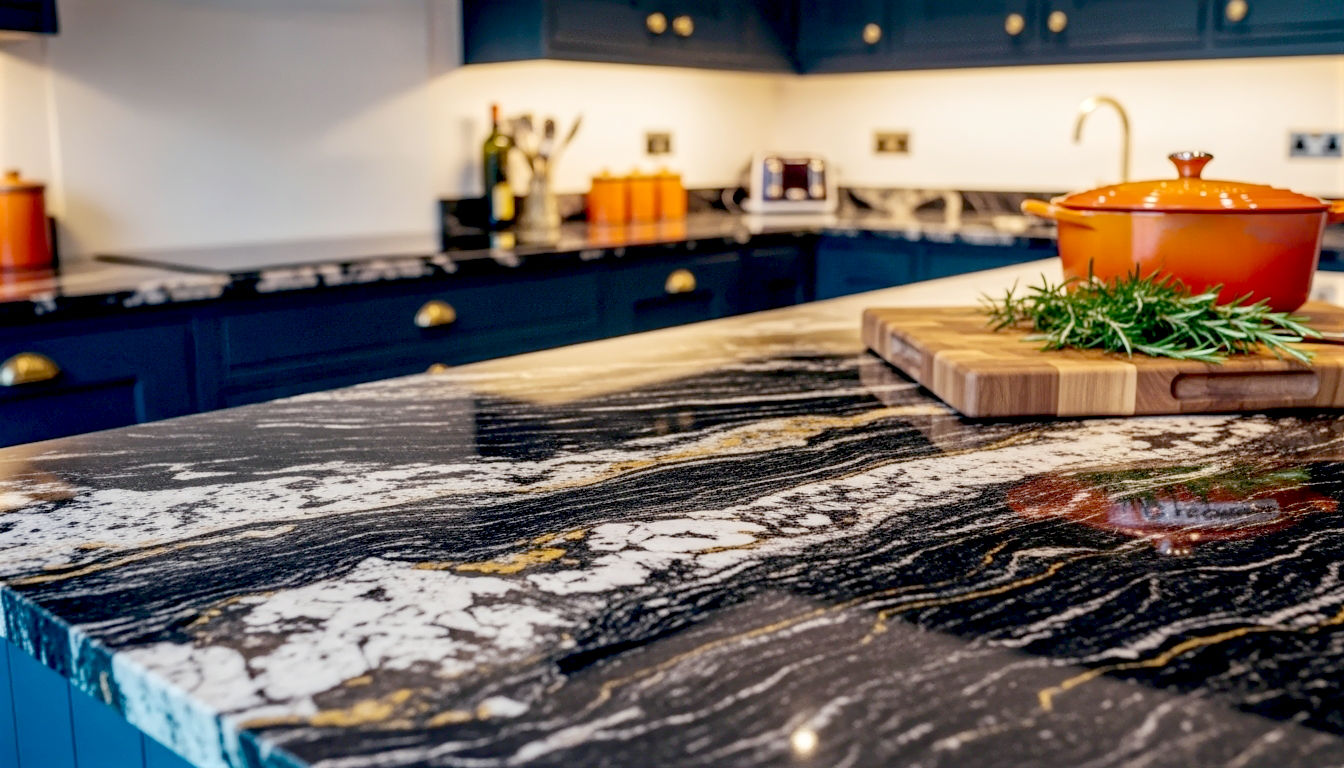The Great British Debate: Are Granite Worktops Actually a Good Choice for Your Kitchen?
Are granite worktops worth the money? Discover the pros and cons, UK costs, and how granite compares to quartz, marble, and wood in our definitive guide.

This post may contain affiliate links. If you make a purchase through these links, we may earn a commission at no additional cost to you.
Walk into almost any high-end kitchen showroom in Britain, and you’ll see them. Sprawling, polished stone surfaces that gleam under the spotlights, cool to the touch and hinting at a kind of timeless luxury. For decades, granite worktops have been the undisputed king of the kitchen, the go-to choice for anyone wanting to add a splash of class and durability to the heart of their home. It’s the stuff of property shows and glossy magazines – a symbol that you’ve ‘made it’.
But let’s be honest, choosing a new worktop isn’t like picking out a new kettle. It’s a huge decision. It costs a pretty penny, and it’s something you’ll have to live with, cook on, and look at every single day for years. So, the big question is, in a world now filled with dazzling alternatives like quartz and sleek, modern laminates, are granite worktops still a good choice? Are they truly worth the investment, or are we just clinging to an old idea of luxury?
This isn’t just about what looks nice. It’s about practicality, money, and making a choice that fits your life, whether you’re brewing a quick cuppa in a tiny city flat or prepping a massive Sunday roast in a sprawling country kitchen. We’re going to dig deep into the world of granite, uncovering everything you need to know. We’ll explore where it comes from, how it’s made, and what it’s really like to live with. We’ll weigh up the good, the bad, and the downright messy, so you can decide for yourself if this famous stone still deserves its crown.
What on Earth is Granite, Anyway?
Before we decide if it’s any good on top of your kitchen cabinets, it helps to know what granite actually is. It’s a word we hear all the time, but most of us would be hard-pressed to explain it.
In simple terms, granite is a type of rock forged deep within the Earth’s crust. Think of it as a bit of geological magic. It all starts with magma – that’s the molten, fiery rock bubbling away miles beneath our feet. This magma, over millions and millions of years, slowly cools down and crystallises. It’s this incredibly slow cooling process that allows large, beautiful crystals to form, which give granite its signature speckled and grainy appearance. The word ‘granite’ itself comes from the Latin ‘granum’, which means ‘grain’.
The main ingredients in this geological recipe are two minerals: quartz and feldspar. You’ll also find little bits of other minerals like mica and amphibole mixed in, and it’s these extras that create the huge variety of colours and patterns we see.
- Quartz is usually a milky white or clear, glassy mineral. It’s incredibly hard, which is one of the main reasons granite is so tough and scratch-resistant.
- Feldspar is what gives granite most of its colour, from pale pinks and creams to deep blacks and greys.
- Mica adds the little shiny, silvery, or black flakes that sparkle when they catch the light.
Because granite is a completely natural product, cooked up by Mother Nature, no two slabs are ever the same. The exact mix of minerals, the pressure it was under, and how slowly it cooled all affect the final look. A piece of granite quarried in Brazil will look completely different from one dug up in India or Italy. This uniqueness is a huge part of its appeal – when you buy a granite worktop, you’re getting a one-of-a-kind piece of the planet’s history.
From Mountain to Kitchen: The Journey of a Worktop
It’s quite a journey from a chunk of rock buried in a mountainside to a polished worktop in a British kitchen.
- Quarrying: It begins in a quarry, which is essentially a giant, open-air mine. Huge blocks of granite, sometimes weighing over 20 tonnes (that’s heavier than three double-decker buses!), are carefully cut from the rock face using diamond-wire saws or controlled explosives.
- Slicing and Dicing: These massive blocks are then transported to a processing plant. Here, they are sliced into more manageable slabs, typically about 20mm or 30mm thick, using enormous saws with diamond-tipped blades. This process can take days for a single block.
- Polishing and Finishing: The raw, rough slabs are then put through a polishing process. A series of rotating pads with increasingly fine diamond abrasives grind the surface down, bringing out the stone’s natural colour, pattern, and shine. This is what creates that classic glossy finish, though other finishes like honed (matte) or leathered (textured) are also available.
- Templating and Fabrication: Once the slabs reach a UK supplier, the final stage begins. A specialist will visit your home to create a precise template of your kitchen cabinets, including cut-outs for the sink and hob. This template is then used back at the workshop to cut your chosen slab to the exact size and shape needed. This is a highly skilled job, requiring computer-guided saws and water jets to get a perfect finish.
- Installation: Finally, the finished worktop is carefully delivered and installed in your kitchen by a team of professionals. It’s a heavy, delicate job that is definitely not a DIY task!
The Great Debate: The Pros and Cons of Granite Worktops
Okay, let’s get down to the nitty-gritty. Is granite the right choice for your kitchen? To figure that out, we need to have an honest look at both its shining strengths and its potential weaknesses.
The Upsides: Why People Fall in Love with Granite
There are some very good reasons why granite has been so popular for so long.
1. It’s Incredibly Durable and Hard-Wearing
This is granite’s superpower. Remember that super-hard quartz mineral we talked about? It makes granite one of the toughest materials you can put in your kitchen. It’s incredibly difficult to scratch. You could chop vegetables directly on it, and you’d be more likely to blunt your knife than damage the worktop (though we don’t recommend it – it’s terrible for your knives!).
This toughness makes it perfect for the chaos of a busy family kitchen. It can handle dropped pans, sliding plates, and general wear and tear far better than materials like laminate or wood.
2. It’s a Pro When It Comes to Heat
Granite was born from molten rock, so it’s naturally brilliant at handling heat. You can take a hot pan straight from the hob or oven and place it directly onto a granite surface without worrying about scorching, burning, or leaving a mark. This is a huge advantage over laminate, which can melt, or wood, which can scorch easily. It gives you a real sense of freedom when you’re in the middle of cooking a complicated meal.
3. Every Single Piece is Unique and Beautiful
This is perhaps granite’s biggest selling point. It’s not a factory-made, uniform product. Each slab has its own unique swirls, veins, and flecks of colour. Choosing a granite worktop is like choosing a piece of art for your kitchen. You can spend hours looking at different slabs, finding the one that speaks to you. From the dramatic, swirling patterns of ‘Cosmic Black’ to the subtle, consistent speckles of ‘Kashmir White’, there’s a granite to suit every taste and kitchen style. This natural, one-of-a-kind beauty is something that man-made materials struggle to replicate.
4. It Can Add Real Value to Your Home
Granite worktops are seen as a premium, high-end feature. For many potential homebuyers, a kitchen with granite worktops is a major selling point. While it’s a significant upfront investment, it’s one that can pay off in the long run by increasing the appeal and potentially the value of your property. It sends a message of quality and permanence that other materials often can’t match.
5. It’s Relatively Easy to Clean Day-to-Day
On a daily basis, cleaning granite is a doddle. A simple wipe with a soft cloth, warm water, and a tiny drop of pH-neutral cleaner (like washing-up liquid) is all you need to keep it looking great and free from germs. Spills can be mopped up easily without leaving sticky residues behind.
The Downsides: What You Need to Be Aware Of
It’s not all sunshine and roses. Granite has some characteristics that might make it the wrong choice for some people.
1. It Needs Sealing (and Re-sealing)
Granite is a porous stone. Think of it like a very, very dense sponge. This means that if you leave liquids, especially dark-coloured or acidic ones like red wine, coffee, or lemon juice, to sit on the surface for too long, they can seep into the stone and leave a permanent stain.
To prevent this, granite worktops must be sealed. A sealant is a chemical protector that is applied to the surface, sinks into the pores, and acts as a barrier to stop liquids from getting in. Most new worktops will be sealed by the installer, but this sealant wears off over time. This means you’ll need to re-seal your worktops yourself, typically once every one to three years, depending on the type of granite and how much you use your kitchen.
Forgetting to re-seal it can lead to disaster. That one spilled glass of Merlot during a dinner party could become a permanent, ghostly reminder. This ongoing maintenance is a commitment that not everyone is prepared for.
2. It Can Be Damaged (Yes, Really)
While granite is very hard, it’s not indestructible. It’s a crystalline rock, which means it can be brittle. A heavy impact, especially on an edge or a corner, can cause it to chip or crack. Dropping a heavy cast-iron casserole dish on the edge of your sink cut-out is a common way this happens.
While chips can often be repaired by a professional using a coloured resin, it can be expensive, and the repair may still be visible. A large crack, however, can be a complete nightmare and might mean replacing the entire section.
3. The Cost Can Be a Sticking Point
Let’s not beat around the bush: granite is expensive. It’s one of the pricier options for a kitchen worktop. The price can vary wildly depending on the rarity and origin of the stone, but you can expect to pay significantly more than you would for laminate or wood. The cost isn’t just for the stone itself; you’re also paying for the skilled templating, fabrication, and installation, which are labour-intensive processes. For many people, the high upfront cost is the biggest barrier.
4. The Seams are Visible
Unless you have a very small, straight-run kitchen, your granite worktop will need to have joins, or ‘seams’, where two pieces of stone meet. While a good installer will make these seams as tight and discreet as possible, using a coloured epoxy to match the stone, they will always be visible if you look closely. For some people who want a perfectly flawless, continuous look, this can be a major drawback.
5. It’s a Heavyweight Contender
Granite is incredibly heavy. This isn’t a problem for you to lift, but it’s something your kitchen cabinets need to handle. Most modern, well-built kitchen units can support the weight of a 30mm granite worktop without any issues, but if you have older or lower-quality cabinets, you might need to get them reinforced, which is an extra hassle and cost.
Granite vs. The World: How Does It Stack Up Against Other Materials?
To really understand granite’s place in the modern kitchen, we need to compare it to the other popular choices in the UK.
Granite vs. Quartz
This is the big showdown, the heavyweight championship of kitchen worktops. Quartz is granite’s main rival and, in recent years, has become even more popular.
- What is it? Quartz worktops are engineered stone. They’re made from about 90-95% crushed natural quartz (the same mineral that makes granite hard) mixed with resin, polymers, and pigments.
- The Look: Because it’s man-made, quartz can be produced in a huge range of consistent colours and patterns, from brilliant whites and bold, block colours to designs that mimic marble or concrete. The look is very uniform, with no natural variations.
- The Verdict: Quartz is the winner on maintenance. It’s non-porous, meaning it doesn’t need sealing and is highly resistant to staining. It’s just as durable and heat-resistant as granite (though some resins can be damaged by very extreme, sudden heat changes). The main difference is aesthetic. If you love the unique, natural, one-of-a-kind patterns of stone, granite wins. If you want a perfectly consistent, predictable colour and pattern (especially a pure white), and zero maintenance, quartz is your champion.
Granite vs. Marble
Marble is the epitome of classic, timeless luxury, often seen in grand hotels and stately homes.
- What is it? Like granite, marble is a natural stone. However, it’s a metamorphic rock formed from limestone, which makes it much softer and more porous.
- The Look: Marble is famous for its soft, creamy appearance and its beautiful, delicate veining. It has an elegance that is hard to beat.
- The Verdict: While it might be one of the most beautiful materials, marble is much less practical for a kitchen than granite. It’s very soft, so it scratches and chips easily. It’s also extremely porous and will stain almost instantly if you spill anything acidic like lemon juice or vinegar on it. This is known as ‘etching’ and it dulls the surface. For most busy kitchens, granite is the far more sensible and durable choice. Marble is better suited to low-traffic areas like bathrooms or for a statement baking station if you’re a keen pastry chef.
Granite vs. Wood
Wooden worktops offer a warm, natural, and traditional feel, perfect for country-style or rustic kitchens.
- What is it? Usually made from hardwoods like oak, walnut, or iroko.
- The Look: Wood brings a warmth and character to a kitchen that stone can’t. It can also develop a beautiful patina over time.
- The Verdict: Wood is on the opposite end of the spectrum from granite in terms of maintenance. It needs regular oiling (sometimes several times a year) to keep it waterproof and protected. It scratches and dents very easily, and it’s not heat-resistant – you can’t put hot pans on it. It’s also susceptible to water damage, especially around the sink, where it can turn black and rot if not properly cared for. While beautiful, it’s a high-maintenance choice. Granite is overwhelmingly more durable and practical.
Granite vs. Laminate
Laminate is the budget-friendly champion and the most common worktop material in the UK.
- What is it? A layer of plastic laminate is bonded to a chipboard core.
- The Look: Modern laminates have come a long way. You can now get very convincing replicas of stone, wood, and concrete, as well as a huge array of colours and patterns.
- The Verdict: The main advantage of laminate is its price – it’s a fraction of the cost of granite. It’s also easy to clean and requires no special maintenance. However, it’s the least durable option by a long shot. It can be scratched, it’s not heat-resistant (a hot pan will melt the surface), and any deep cut that exposes the chipboard core can lead to water getting in and causing the worktop to swell and blow. It also lacks the premium feel and longevity of stone. Granite is a long-term investment in durability and quality; laminate is a short-term, budget-friendly solution.
Practical Advice for the British Homeowner
So, you’ve weighed the pros and cons, and you’re still tempted by granite. Here’s what you need to know to make a smart purchase.
Choosing Your Slab: A Hands-On Job
Because every slab is unique, you should never, ever choose your granite worktop from a small sample in a showroom. A tiny square can’t possibly show you the full pattern, the flow of the veins, or any large mineral deposits you might not like.
Always go to the stone yard or supplier’s warehouse to see the full-size slabs for yourself. This is the only way to get a true feel for what it will look like in your kitchen. Take a door sample from your kitchen cabinets and a tile from your floor with you to see how the colours work together. Look at the slab in natural light if possible. This is your chance to pick the exact piece of stone that will be yours.
Understanding the Finishes
The finish you choose has a big impact on both the look and the practicality of your worktop.
- Polished: This is the classic, high-gloss finish. It reflects lots of light, makes colours appear richer and darker, and really shows off the stone’s character. It’s the easiest to keep clean, but it will show fingerprints and smudges more readily.
- Honed: A honed finish is smooth but matte, with little to no shine. It gives a softer, more contemporary look. It can be more susceptible to showing oily fingerprints and is slightly more porous than polished granite, so it needs to be sealed diligently.
- Leathered/Brushed: This finish has a soft sheen and a textured, bumpy feel, a bit like a piece of leather. It’s great at hiding fingerprints and water spots and gives a really interesting, tactile quality to the stone. It’s a great compromise between polished and honed.
What About the Cost in the UK?
The price of granite worktops in the UK can vary enormously. You could be looking at anything from £200 to over £700 per square metre, supplied and fitted.
The final price depends on several factors:
- The Rarity of the Stone: Common, widely available granites will be at the lower end of the scale. Rare, exotic stones with dramatic patterns that are only found in one or two quarries in the world will be much, much more expensive.
- The Thickness: 30mm is the standard thickness and is more robust (and expensive) than the thinner 20mm option.
- The Complexity of the Job: A simple, straight run will be cheaper than a U-shaped kitchen with multiple corners, a breakfast bar, and complicated cut-outs for an undermount sink and hob.
- The Fabricator: Prices can vary between different suppliers, so it’s always worth getting at least three quotes. But remember, don’t just go for the cheapest. Look for a reputable company with good reviews and a long history – the quality of the templating and installation is just as important as the quality of the stone itself.
Caring for Your Granite: The Dos and Don’ts
Living with granite isn’t difficult, but you need to follow a few simple rules to keep it looking its best.
- DO clean up spills quickly, especially acidic ones like wine, fruit juice, and vinegar.
- DO use a pH-neutral cleaner. A bit of washing-up liquid in warm water is perfect.
- DO use chopping boards. While the granite can take it, your knives can’t!
- DON’T use harsh chemical cleaners, bleach, or abrasive scouring pads. These can damage the sealant and dull the surface of the stone.
- DON’T drag heavy, rough-bottomed pots (like cast iron) across the surface, as this could potentially cause fine scratches over time.
- DO test your sealant once a year. Drip a small puddle of water onto the surface. If it beads up, your sealant is fine. If it starts to darken the stone and soak in after a few minutes, it’s time to re-seal.
The Final Verdict: So, Are Granite Worktops a Good Choice?
After all that, we come back to our original question. The honest answer is: yes, granite worktops are still an excellent choice, but they are not the only choice, and they are not the right choice for everyone.
Granite is a fantastic option if you:
- Love natural, unique beauty and want a one-of-a-kind statement piece in your kitchen.
- Are a keen cook who needs a durable, heat-resistant surface that can stand up to heavy use.
- Are prepared for a small amount of regular maintenance in the form of re-sealing every few years.
- View your worktop as a long-term investment that will add value and quality to your home.
However, granite might not be the best choice for you if you:
- Want a completely maintenance-free worktop and don’t want to ever think about sealing. In this case, quartz is probably a better bet.
- Are on a tight budget. The high cost of granite can be a deal-breaker, and a high-quality laminate might be a more sensible option.
- Desire a perfectly uniform, consistent look with no natural variations or visible seams.
Ultimately, the great worktop debate isn’t about which material is definitively ‘best’, but which one is best for you. Granite earned its reputation for a reason. It is a stunningly beautiful, incredibly tough, and wonderfully practical material that brings a piece of the Earth’s ancient history into the heart of your home. It has its quirks and requires a little care, but for those who value its unique character and rock-solid performance, granite remains a king among worktops.
Further Reading
For those looking to dive even deeper, here are some highly respected resources in the UK:
- The Natural Stone Specialist: A leading publication for the stone industry in the UK, offering in-depth articles and news.
- Stone Federation Great Britain: The official trade association for the natural stone industry, providing reliable information and a directory of accredited members.
- Houzz UK: A great platform for design inspiration, with thousands of photos of British kitchens featuring granite worktops and forums to ask questions.






